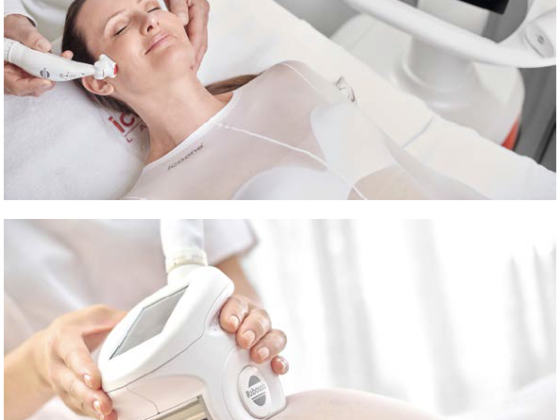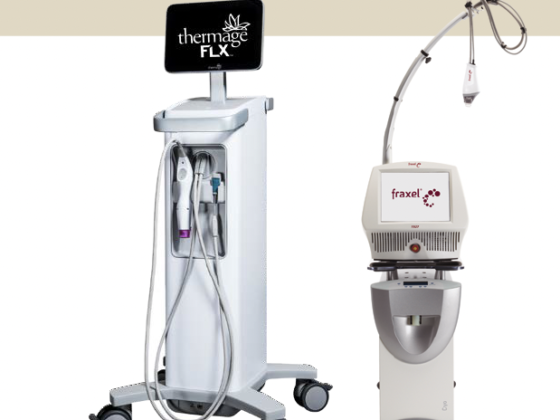By Doctor Olivier Claude
The new generation of tensor threads enables us to treat sagging skin without surgery. This new tool is particularly useful for treating the oval of the face by correcting jowls, expression lines and nasolabial folds.
The first styles of threads did not have a very good reputation and were seldom used. These “gold or Russian threads” were not very effective, which means that surgeons often had to use a large number of threads to achieve the desired result. Furthermore, they were generally non-resorbable in order to make the results more long-term. This could lead to intolerance, which sometimes rendered the threads visible or palpable.
Today, new technologies enable us to implant completely resorbable threads, which lends a vital level of safety to the practice. The material used is the same as for surgical sutures which have been used for several decades. They are made of polylactic acid, which is biocompatible and bioresorbable. This hindsight means that we can have complete confidence in how the threads we have placed will evolve.
The threads are gradually resorbed over a period of 2 years.
The firming effect is created by small cones which anchor the tissues all the way around (360°). This approach gives better resistance than barbed threads and is also better tolerated, since the cones have a completely smooth surface. The slow and gradual breakdown of the cones leaves behind a small fibrous capsule, which makes the lifting effect last even longer.
Threads or hyaluronic acid injections?
These techniques are not in opposition: they are complementary tools that work in synergy with one another. In very simple terms, hyaluronic acid is recommended to restore the deep supporting framework of the face. Modern injections are often carried out in the upper two thirds of the face in order to recreate the inversed triangle of youth. This helps us to avoid weighing down the lower face, where the main problem is sagging skin and not a loss of volume. In fact, over-injection in this area would create a face that is too round and unnatural-looking with altered expressions. This is when threads are recommended for treating the oval of the face. In general, they are used after hyaluronic acid injections have been carried out in the upper face. By performing the techniques in this order, we can properly identify the areas of sagging skin that have not been corrected by the injections.
Which areas of the face can be treated using threads?
The lower third of the face − in particular the jowls, nasolabial folds and expression lines − are the areas which offer the best results. The neck can also be improved by creating better definition in the cervical-mandibular angle. The face thus looks younger and more dynamic without being weighed down.
Who can benefit from this technique?
The ideal patient is usually aged between 35 and 45. They are generally men or women (20% men) who present the beginnings of a sagging oval.
The second group of patients is made up of suitable candidates for a cervical-facial lift, often aged between 45 and 55, but who want to postpone surgery by at least a year, for either personal or professional reasons.
Finally, older patients (often aged over 60) who have been advised not to have a general anaesthetic can also benefit from this technique. The results will, of course, be less dramatic than with surgery, but they enable the patient to turn the clock back a few precious years.
What happens during the thread-placing session?
A thread-placing session lasts around 45 minutes. It leaves no scarring and does not require anaesthetic. Patients can go back to work the very next day. In cases where the skin is very thin or if the patient is in contact with the public, they are recommended to take 24 to 48 hours off due to the possibility of mild swelling.
The new generations of threads enable us to rejuvenate the oval of the face in perfect synergy with hyaluronic acid injections. This approach does not rule out a cervical-facial lift, which is the go-to procedure for the lower face. But it allows us to treat patients who are not yet candidates for a surgical lift or those who are no longer suitable for surgery.
Plastic and Cosmetic Surgeon – Paris. Qualified in Plastic, Reconstructive and Cosmetic Surgery. D.E.S.C. medical specialisation diploma in Plastic and Cosmetic Surgery. Graduated from the French College of Plastic Reconstructive and Cosmetic Surgery. Member of the American Society for Aesthetic Plastic Surgery – ASAPS. Member of the French Society of Plastic, Reconstructive and Cosmetic Surgery – SOFCPRE.













